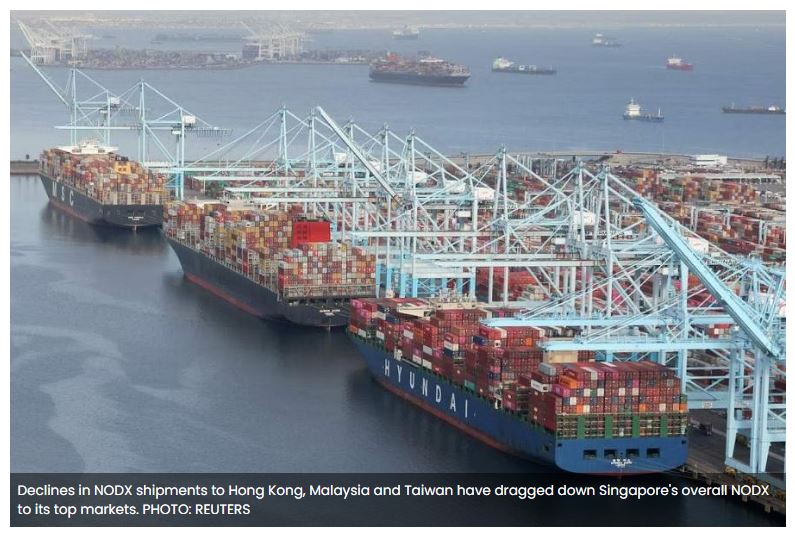Singapore key exports surprise with larger-than-expected 14.7% drop in May
SINGAPORE’S non-oil domestic exports (NODX) were down a surprising 14.7 per cent in May, a steeper slide than April’s 9.8 per cent contraction, data from Enterprise Singapore (EnterpriseSG) showed on Friday (Jun 16).
Shrinking for the eighth consecutive month, the month’s fall in key exports far surpassed the median 7.7 per cent drop forecast by economists in a Bloomberg poll. Both electronics and non-electronics exports continued to decline on a year-on-year basis.
This latest data reflects persistent trade headwinds and the difficult global external environment, said DBS economist Chua Han Teng and HSBC economist Yun Liu.
Noting the “broadly weaker than expected” readings in 2023 so far, RHB senior economist Barnabas Gan expects NODX to continue to contract into Q3, before recovering in the final quarter.
The bank has downgraded its full-year NODX growth forecast to -8 per cent, from 0 per cent previously. In May, EnterpriseSG also cut its full-year NODX growth forecast, to -8 per cent to -10 per cent.
On a seasonally adjusted monthly basis, NODX dropped 14.6 per cent last month, reversing from April’s 2.6 per cent growth.
This was “largely a seasonal correction” to strong momentum earlier, but NODX momentum is “far from seeing a meaningful recovery”, said Yun. Both electronic and non-electronic shipments declined month on month.
Key exports’ value fell to S$13.8 billion in May, down from S$16.1 billion the month before. It also remained lower than the year-ago period’s S$17.1 billion and 2022’s average of S$16.6 billion.
Year on year, electronics exports shed 27.2 per cent in May, deepening from April’s 23.3 per cent loss. The decline was led by integrated circuits (ICs) (-39.2 per cent), disk media products (-41.6 per cent) and parts of ICs (-48.7 per cent).
“A bottom in Singapore’s electronics exports slump has yet to be seen,” said Chua. “The near-term outlook for electronics exports remains uncertain, given that inventory destocking, for example, in the global semiconductor market is still ongoing. This is despite the medium-term potential and optimism over AI (artificial intelligence) chips observed in the news recently.”
While Yun agreed that there has yet to be a “meaningful turnaround” in the global electronics cycle on AI-related optimism, she noted “some initial signs that Singapore’s trade may not be far from bottoming out”.
Non-electronics shipments in May lost 10.7 per cent from the year-ago period, accelerating from the 5.8 per cent decline in April. Contributing most to the drop were specialised machinery (-23.4 per cent), petrochemicals (-22.8 per cent) and pharmaceuticals (-14 per cent).
Barclays economist Brian Tan noted that shipments for usually-volatile pharmaceuticals more than halved sequentially in May – but this was a normalisation after it “surged to heady levels in March-April”.
The latest NODX print comes after Singapore’s manufacturing purchasing managers’ index (PMI) remained in contractionary territory in May, for the third straight month.
On the whole, NODX to Singapore’s top 10 markets declined in May, led by falls in exports to Hong Kong (-41.2 per cent), Malaysia (-26.2 per cent) and Taiwan (-19.4 per cent).
Shipments to all other top markets also posted declines, except for NODX to China and the US. Key exports to the EU and South Korea booked reversals, contracting in May after posting growth in the month before.
NODX to the US grew, up 4.8 per cent in May – but it had posted 40.7 per cent growth in April. Shipments to China, which contracted 20.9 per cent year on year in April, expanded 3.7 per cent in May.
“May 2023’s NODX upswing to China stood out despite recent Chinese data showing that its post-pandemic economic recovery, for instance in the industrial sector, is losing steam,“ said Chua.
He and Yun agreed that it is premature to conclude that exports to China has turned into a boost for overall NODX, with Chua noting China’s bumpy post-pandemic recovery.
But Yun said that it is a “meaningful improvement”. Although the trade boost from China may be limited, given the nature of its consumption-led recovery this round, some support from the country’s demand to prevent Singapore’s trade from sliding further is welcoming.
In line with the decline in NODX, total trade fell 17.9 per cent year on year in May, easing slightly from April’s 18.9 per cent drop. Exports last month contracted by 15.2 per cent, while imports fell by 20.7 per cent. In April, total exports declined by 18.1 per cent and total imports fell 19.7 per cent.
On a seasonally adjusted monthly basis, total trade also shrank, down 5.6 per cent in May, extending April’s 3.7 per cent dip; the level of total trade reached S$94.5 billion, less than the preceding month’s S$100.1 billion. Both exports and imports decreased.
“The disappointing trade dynamics seen are not isolated to Singapore,” said Gan, noting year-on-year export declines in Asian economies such as Taiwan, South Korea and China in May, as well as continued contractionary PMI manufacturing prints in export-oriented Asian economies.
Based on the latest quarterly survey of professional forecasters, private-sector economists have downgraded their full-year economic growth forecast for Singapore, partly due to a deeper slump in NODX.
Gan expects a double-digit contraction for May’s industrial production and a consequent 1.4 per cent year-on-year fall in Q2 gross domestic product.
“Singapore faces a heightened risk of a technical recession in H1 2023,” he said.
But he also noted “some improvement in risk appetite following the uptick in manufacturing momentum across Asia and in recent global equity valuations”.
Key global central banks likely approaching their peak rate objectives, easing inflation dynamics across key Asian economies, and the hope for more clarity on China’s reopening efforts could lead to a better global growth prognosis in H2 2023, said Gan.
Yun added that a “punchier boost” from China’s re-opening in H2 could have travel-related services “come to the partial rescue” and help prevent a recession this year.
Source: https://www.businesstimes.com.sg/singapore/singapore-key-exports-surprise-larger-expected-147-drop-may


 English
English




